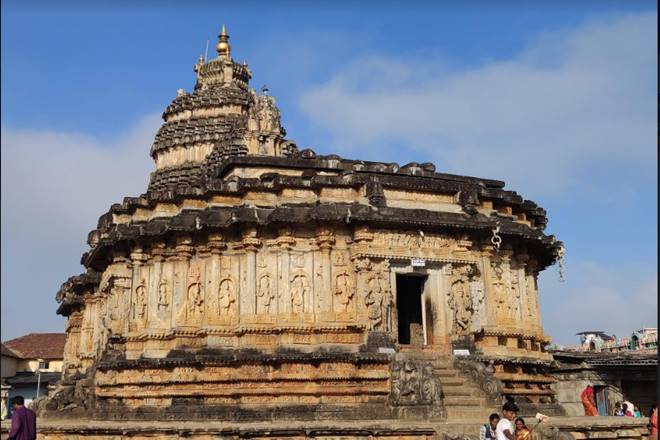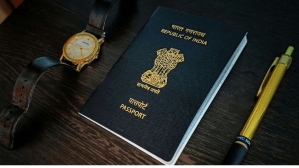By Asha Balakrishnan
Mahashivratri 2020: There are times in our life when we plan much, and work hard but things don’t fall in place and then there are times when things effortlessly fall in place. Our recent trip to Sringeri in Western ghats was one such. It was not in our itinerary when we left home, but the spiritual monastery beckoned us and we drove from Chikmagalur through the hairpin bends flanked by scenic coffee estates to Sringeri.
It was sheer grace that we had a comfortable vision of the beautiful deity of Sharadamba and other shrines within the complex. After the darshan, we were heading towards the exit to our room, suddenly my children decided to take a look at River Tunga. We walked by the beautiful 14th century Vidyashankara temple and reached the bridge over the river. Soaking the beauty of the moonlit river under the star-spangled sky, we walked on the bridge aimlessly in silence not knowing where we were heading. We saw a handful of men in traditional wear of dhoti and a few women in nine yards saree walking ahead of us. We followed them on the bridge into the woody orchard Narsimhavana and saw it opening into the portico of Guru Nivas. Traditionally dressed devotees, less than 100 in number, were seated in a well- lit hall. Unknowingly, we had walked into the home, where the spiritual head, His Holiness Bharati Theertha Swamiji was to begin a pooja in a few minutes.
What followed after that was one of the most divine experiences I have had in recent times. It was a surreal feeling to watch the Chandramouleeswara pooja in the night to the invigorating Vedic chants by the young students of the Vedic school. The Chandramouleeswara is a crystal linga, the principal idol of worship not only in Sringeri but also the other monasteries — Badri, Dwaraka, and Puri established by Adi Shankara. Legend has it that this spatika linga along with the other three was handed over by Lord Shiva himself to Adi Shankara, who in turn gave to his 4 disciples, one of whom was Mandana Misra, his first disciple and the first Acharya of the Sringeri Mutt. Since then, the linga has been propitiated by the various Acharyas who have adorned the peetams and what I saw was the pooja performed by the present Acharya, a renowned scholar, the 36th in the line of Guru Parampara. The ambience, the rhythmic chants, the vibrations I felt here are inexplicable.
After the pooja when we crossed over the river bridge, I felt I was charged with supreme bliss. It is what one calls as a spiritual moment that has to be internalized. Spiritual can mean many things to many, it is a broad concept with room for many perspectives, as in connecting with the self, the supreme, blissful solitude, a belief that tells you to give up your anger, ego, hate and many more.
Though temples are God’s abode, there are a few temples where one has that feeling. The older the temple, the more such intangible feeling. I sense such vibes in a few ancient temples which are built according to Agamic principles (temple architecture). Here I would like to recall a visit to an old temple again by default.
One of my favourite travel routes is the Thanjavur-Trichy belt in Southern Tamil Nadu. The numerous criss-crossing canals and the tributaries of River Cauvery which meander around the little villages adorned with lush green fields are a sight to behold. The river banks are home to many world heritage sites like the Brihadeeswarar temple, Gangaikonda Cholapuram, Darasuram etc.,
I have often traveled this route and each time I visit, I am enriched. It was during one such travel, on the main road from Kumbakonam to Thanjavur, we found a temple arch with 108 Shiva temples written on it. Intrigued, we stopped by the temple. At first glance, it didn’t seem like a big temple and did not have a ‘tall temple tower’ characteristic of the other temples in the region. We walked into the temple and saw the main deity named Ramalinga Swamy, another one called Hanumathlingam and the rest of the 106 lingams were in 3 rows.
The temple priest in the unpretentious temple where only we were the devotees said that worshipping Lord Shiva here would remove one of all sins, hence the name of the place, Papanasam.
He went on to tell the sthala puranam (history of the place). The story related to the temple goes like this.
Lord Rama, after worshipping at Rameswaram to ward off the evil effects of killing Ravana, found the sins were still following him due to the killing of Kara and Dhooshana in the war. He instructed Lord Hanuman to bring one Shivalinga from Kashi. Since it got delayed, Rama and Sita themselves collected sand from nearby river Kudamurutty (a branch of Cauvery) and made 107 Shiva lingams under a vilva tree. Meanwhile, Hanuman brought the Shivalinga, it was named Hanumanlinga. Thus the total lingas numbered 108. This place is also called Keezh Rameswaram and possibly the only ancient place in the world where 108 big separate lingams are present in one place. It is believed that one’s wish is realized if one circumambulates the outer praharam by 108 times and during Mahashivarathri nearly 10,000 people circumambulate this temple.
The idols in ancient temples built according to agama shastra are said to have esoteric power due to chantings than the newly constructed designer temples. One need not be spiritual or a theist to visit such temples, but if one loves history, art, heritage, architecture, such temples will be deeply appreciated.
(The author is a travel writer. Views expressed are personal.)








